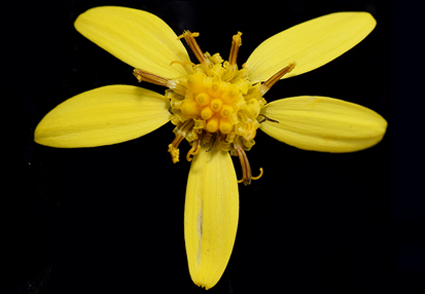Abstract
Synotis carnosifolia (Asteraceae, Senecioneae), a new species from Baoshan in western Yunnan province, China, is described and illustrated. By its habit S. carnosifolia is most closely similar to S. cavaleriei and S. changiana. It differs from S. cavaleriei in its petioles 1–3 cm long, leaf blade elliptical, orbicular or obovate and carnose. It can readily be distinguished from the latter by its leaf blade elliptical, orbicular or obovate, 4–7 × 2–6 cm, carnose in texture, abaxially arachnoid or subglabrous, adaxially glabrous, and blades base rounded. The taxonomic position of the new species within Synotis is also corroborated by evidence from phylogenetic analyses based on ITS and ETS sequence data.
References
- Chen, Y.L. (1995) The new species of the tribe Senecioneae (Compositae) from China. Acta Phytotaxonomica Sinica 33 (1): 76−85.
- Chen, Y.L. (1999) Senecioneae Cass. In: Chen, Y.L. (Ed.) Flora Reipublicae Popularis Sinicae, vol. 77. Science Press, Beijing, 326 pp.
- Chen, Y.L., Nordenstam, B. & Jeffrey, C. (2011) Synotis (C. B. Clarke) C. Jeffrey & Y.L. Chen. In: Wu, Z.Y., Raven, P.H. & Hong, D.Y. (Eds.) Flora of China, vol. 20−21. Science Press & Missouri Botanical Garden Press, Beijing & St. Louis, pp. 489−505.
- Clarke, C.B. (1876) Compositae Indicae. Thacker, Spink and Company, Calcutta, 347 pp.
- Guindon, S., Dufayard, J.F., Lefort, V., Anisimova, M., Hordijk, W. & Gascuel, O. (2010) New algorithms and methods to estimate maximum-likelihood phylogenies: assessing the performance of PhyML 3.0. Systematic Biology 59: 307–321. https://doi.org/10.1093/sysbio/syq010
- Hall, T.A. (1999) BioEdit: A user-friendly biological sequence alignment program for Windows 95/98/NT. Nucleic Acids Symposium Series 41: 95–98.
- Jeffrey, C. & Chen, Y.L. (1984) Taxonomic studies on the tribe Senecioneae (Compositae) of Eastern Asia. Kew Bulletin 39 (2): 205–446. https://doi.org/10.2307/4110124
- Katoh, K. & Standley, D.M. (2013) MAFFT multiple sequence alignment software version 7: improvements in performance and usability. Molecular Biology and Evolution 30: 772–780. https://doi.org/10.1093/molbev/mst010
- Léveillé, H. (1913) ⅭⅢ. Decades plantarum novarum. CⅩⅩⅥⅠ–ⅭⅩⅩⅪ. Repertorium Specierum Novarum Regni Vegetabilis 12: 531–538. https://doi.org/10.1002/fedr.19130123306
- Linnaeus, C. (1753) Species Plantarum. Laurentius Salvius, Stockholm, 1200 pp.
- Nguyen, L.T., Schmidt, H.A., Haeseler, A. & Minh, B.Q. (2015) IQ-TREE: a fast and effective stochastic algorithm for estimating maximum-likelihood phylogenies. Molecular Biology and Evolution 32: 268–274. https://doi.org/10.1093/molbev/msu300
- Ronquist, F. & Huelsenbeck, J.P. (2003) Mrbayes 3: Bayesian phylogenetic inference under mixed models. Bioinformatics 19: 1572–1574. https://doi.org/10.1093/bioinformatics/btg180
- Tang, M., Wang, L.Y. & Yang, Q.E. (2013) Synotis xinningensis (Asteraceae), a new species from Hunan, China. Botanical Studies 54: e16. https://doi.org/10.1186/1999-3110-54-16
- Tong, T.J., Tang, M., Ren, C. & Yang, Q.E. (2017) Senecio kumaonensis (Asteraceae, Senecioneae) is a Synotis based on evidence from karyology and nuclear ITS/ETS sequence data. Phytotaxa 292 (1): 35–46. https://doi.org/10.11646/phytotaxa.292.1.3
- Zhang, D., Gao, F.L., Jakovlic, I, Zou, H., Zhang, J., Li, W.X. & Wang, G.T. (2020) PhyloSuite: an integrated and scalable desktop platform for streamlined molecular sequence data management and evolutionary phylogenetics studies. Molecular Resources 20: 348–355. https://doi.org/10.1111/1755-0998.13096
- Zhao, L.C., Ren, C., Yu, Z.Y., Tang, M. & Yang, Q.E. (2023) Synotis jinpingensis (Asteraceae, Senecioneae), a new species with white ray florets from southeastern Yunnan, China. PhytoKeys 235: 199–210. https://doi.org/10.3897/phytokeys.235.112230


